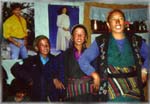revision 23oct05
http://www.greenkiwi.co.nz/footprints/frames/mu_print.htm
In 2005 we once again ran a successful
trek to Mustang.
In response to requests we offer this trek again in 2007.
We have trekked several times in Mustang, developing what we
feel is the best possible trek. To walk in Mustang is an exceptional experience.
At this date there are spaces available on the trek.
![]() was astonished when I first went to Mustang. All my reading,
my hours of examining maps and photos, did not match the intensity of direct
experience. To visit Mustang is to journey towards the very beginnings of
earth’s history. A journey to experience reminders of our earliest ancestors.
was astonished when I first went to Mustang. All my reading,
my hours of examining maps and photos, did not match the intensity of direct
experience. To visit Mustang is to journey towards the very beginnings of
earth’s history. A journey to experience reminders of our earliest ancestors.
 This is ancient landscape and an age old way of life. This is land where earth’s
very bones are laid bare. A skeletal land, harsh, dry and primal. A land where
eroded edges of old lake sediment have been shaped by water and wind to fairy
castles of startling pink and towers of solid ochre. Where cliffs punctuate
with echoes of early humans who dug in silty walls to create multi-storied
homes and painted their troglodyte-temple walls with murals of breathtaking
beauty.
This is ancient landscape and an age old way of life. This is land where earth’s
very bones are laid bare. A skeletal land, harsh, dry and primal. A land where
eroded edges of old lake sediment have been shaped by water and wind to fairy
castles of startling pink and towers of solid ochre. Where cliffs punctuate
with echoes of early humans who dug in silty walls to create multi-storied
homes and painted their troglodyte-temple walls with murals of breathtaking
beauty.
That same sediment is cemetery to 65-million-year-long-dead ammonites which
trickle into river shingle becoming shaligrams, the ‘fossilised insects’ revered
by Hindus as manifestations of Lord Vishnu, the Preserver of Life. In side
canyons abandoned irrigation channels, old terraced fields and crumbling walls
of prayer stones tell of times that were more populous and less desiccated
than today.
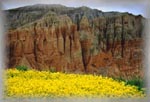 Yet, after walking hours through bone-dry land you startle upon the crest
of a canyon. Below wide swathes of irrigated barley have such intensity of
greenness that they numb eyes adjusted to vistas of high desert. In flat roofed
villages are people whose lives are little different from their ancestors
who dwelt in the caves above.
Yet, after walking hours through bone-dry land you startle upon the crest
of a canyon. Below wide swathes of irrigated barley have such intensity of
greenness that they numb eyes adjusted to vistas of high desert. In flat roofed
villages are people whose lives are little different from their ancestors
who dwelt in the caves above.
This is a very special place.
![]() ong ago, before Lucy walked the plains of Africa, before the
dinosaurs ruled, before even the tiniest mammals had made their shaky start
upon this planet there was a sea where the Himalaya now stand. This mighty
sea of Tethys had a far horizon, rolling south from Europe and Asia; extending
to an isolated India and Africa and further south to Gondwana that was to
become Antartica, New Zealand and other southern lands. Eventually earth’s
fractured mantle freed the Indian plate to sail north, and over countless
millenia, crash against the bulk of Asia. This fifty million year old collision
created and continues to force up the Himalaya, Abode of the Gods, even today.
A collision that smashed and folded earth's crust in wrinkled edges that are
the hills of Burma, the Karakoram and the Kun Lun.
ong ago, before Lucy walked the plains of Africa, before the
dinosaurs ruled, before even the tiniest mammals had made their shaky start
upon this planet there was a sea where the Himalaya now stand. This mighty
sea of Tethys had a far horizon, rolling south from Europe and Asia; extending
to an isolated India and Africa and further south to Gondwana that was to
become Antartica, New Zealand and other southern lands. Eventually earth’s
fractured mantle freed the Indian plate to sail north, and over countless
millenia, crash against the bulk of Asia. This fifty million year old collision
created and continues to force up the Himalaya, Abode of the Gods, even today.
A collision that smashed and folded earth's crust in wrinkled edges that are
the hills of Burma, the Karakoram and the Kun Lun.
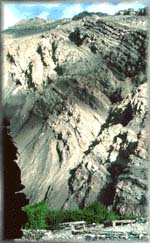 Like some gigantic bedspread these humps and folds forced the waters of that
ancient sea to flow away. Here and there, particularity of landscape created
lakes: confined, salty ones like Nam Tso the great ‘Sky Lake’ of the Tibetan
upland, lakes without outlet; or fresh-water ones like that which inundated
the whole of the Mustang basin.
Like some gigantic bedspread these humps and folds forced the waters of that
ancient sea to flow away. Here and there, particularity of landscape created
lakes: confined, salty ones like Nam Tso the great ‘Sky Lake’ of the Tibetan
upland, lakes without outlet; or fresh-water ones like that which inundated
the whole of the Mustang basin.
Around those Tibetan plateau lakes, the dry atmosphere and clarity of sky
formed salt deposits metres thick creating wealth for future generations of
merchants. From the very dawn of human habitation rock salt from lakes like
Nam Tso has been traded for hundreds of miles to the salt-hungry lands of
Nepal and western China. Those early Tibetan traders traversing Mustang to
India were following a route created by the same sea that made their salt.
![]()
The water of Tethys drained south as the mountains grew. Cutting through aeons
of sediment and hard basement rock the great rivers of the Himalaya gradually
established their modern pattern. In due course, the greatest gorge in the
world came to lie between Annapurna and Dhaulagiri. Down this rolled the waters
of the Kali Gandaki (Black River) initially a briny torrent and then a mighty
river of fresh silt-laden water draining the great lake overlying the Kingdom
of Lo.
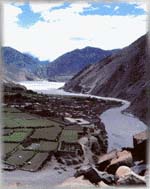 This direct and dramatic slash through the world’s highest mountains is avenue
to things other than water and trade. Acting as a funnel, the gorge of the
Kali Gandaki collects the cooling atmosphere of the Tibetan highlands. Every
afternoon a great mass of air tumbles from Tibetan heights down to the warmth
of the Indian plains. High winds collect dust and small particles that abrade,
crack and dry the skin of mountains and of men.
This direct and dramatic slash through the world’s highest mountains is avenue
to things other than water and trade. Acting as a funnel, the gorge of the
Kali Gandaki collects the cooling atmosphere of the Tibetan highlands. Every
afternoon a great mass of air tumbles from Tibetan heights down to the warmth
of the Indian plains. High winds collect dust and small particles that abrade,
crack and dry the skin of mountains and of men.
![]()
The other great drainpipes of the Tethys sea were more circumspect. Embracing
the very limits of the Himalaya, the Indus and Tsangpo-Bhramaputra curve to
take a much more sinuous route around the mountains. The watershed of the
Himalaya is more than 100 miles north of the main chain; and yet these two
great rivers which have origin within a few miles of each other empty into
different oceans more than 2,000 miles apart. When you trek to Mustang these
geological events are made manifest in the eroded valleys and spines of mountains
that are all about.
Manthang:
......
![]() till presided over by its hereditary Raja the walled city of
Manthang is capital of a kingdom-within-a-kingdom. Set amidst fertile fields
of an irrigated plain, a day from the Tibetan border, the six metre outer
walls speak of times when brigands sought to plunder here. Made rich by centuries
of trade between Tibet and India, Manthang in its hey-day supported perhaps
2,000 citizens.
till presided over by its hereditary Raja the walled city of
Manthang is capital of a kingdom-within-a-kingdom. Set amidst fertile fields
of an irrigated plain, a day from the Tibetan border, the six metre outer
walls speak of times when brigands sought to plunder here. Made rich by centuries
of trade between Tibet and India, Manthang in its hey-day supported perhaps
2,000 citizens.
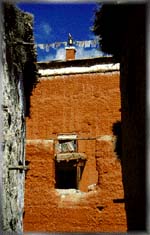 City is too grand a term for this medieval village. Narrow lanes wind between
high walls in such confusion, that despite its size, it is easy to become
disorientated. Behind the walls, city houses lurch up two or three stories
in a confusion of rickety stairs and low-ceiling rooms where vivid carpets
cover seats and sleeping platforms and tiny altars offer incense and water
to the family deities.
City is too grand a term for this medieval village. Narrow lanes wind between
high walls in such confusion, that despite its size, it is easy to become
disorientated. Behind the walls, city houses lurch up two or three stories
in a confusion of rickety stairs and low-ceiling rooms where vivid carpets
cover seats and sleeping platforms and tiny altars offer incense and water
to the family deities.
Each house looks inward away from the public lane. Most date from the 14th
century when Mantang was established. Their inner courtyards and tiny windows
are protection from fierce winds and the numbing cold of winter.
![]()
![]() istorical records of the Upper Mustang region exist from the
8th century. Initially part of a loose collection of feudal states occupying
western Tibet it subsequently came under Nepalese control. The Kingdom of
Lo was founded in 1380 and the present Raja is a direct descendent of the
first ruler. It’s isolation allowed a degree of autonomy which persists to
this day.
istorical records of the Upper Mustang region exist from the
8th century. Initially part of a loose collection of feudal states occupying
western Tibet it subsequently came under Nepalese control. The Kingdom of
Lo was founded in 1380 and the present Raja is a direct descendent of the
first ruler. It’s isolation allowed a degree of autonomy which persists to
this day.
![]()
![]() trategically sited on the easiest trade route through the Himalaya
the people of Lo were both traders and peasant farmers.Great caravans of sheep
and yaks brought loads from Tibet to Lo. Here goods were transferred to mules
and goats, more suited to travel in the warmer lowlands.
trategically sited on the easiest trade route through the Himalaya
the people of Lo were both traders and peasant farmers.Great caravans of sheep
and yaks brought loads from Tibet to Lo. Here goods were transferred to mules
and goats, more suited to travel in the warmer lowlands.
 Southwards the trade was in salt, wool, musk, borax and tsampa; heading north
was rice, corn, textiles and eventually the products of India’s factories.
Political problems with China, the construction of the 'Friendship Highway
linking Kathmandu and Lhasa and, for a time in the sixties, the presence of
Tibetan revolutionaries drastically reduced trade in this region.
Southwards the trade was in salt, wool, musk, borax and tsampa; heading north
was rice, corn, textiles and eventually the products of India’s factories.
Political problems with China, the construction of the 'Friendship Highway
linking Kathmandu and Lhasa and, for a time in the sixties, the presence of
Tibetan revolutionaries drastically reduced trade in this region.
 The trading business is not dead however. So caravans still pass back and
forth like olden times and the Loba remain inveterate traders heading south
as far as India during winter to return in the Spring.
The trading business is not dead however. So caravans still pass back and
forth like olden times and the Loba remain inveterate traders heading south
as far as India during winter to return in the Spring.
![]()
![]() anthang,
is a translation from Tibetan. ‘The Plain of Aspiration’ is a reference to
the hope for enlightenment. A reminder that Buddhism has a very long history
amidst these hills.
anthang,
is a translation from Tibetan. ‘The Plain of Aspiration’ is a reference to
the hope for enlightenment. A reminder that Buddhism has a very long history
amidst these hills.
 Set in a side valley about six hours walk from Manthang is Ghar Gompa. The
‘House Temple’ constructed about 775. The first gompa in all Nepal and earlier
than any gompa built in Tibet it sits alone in a wooded site above the village.
Despite its antiquity, it has been well preserved which is poignantly ironic
as it was initially built to appease demons who several times destroyed the
great temple of Samye near Lhasa.
Set in a side valley about six hours walk from Manthang is Ghar Gompa. The
‘House Temple’ constructed about 775. The first gompa in all Nepal and earlier
than any gompa built in Tibet it sits alone in a wooded site above the village.
Despite its antiquity, it has been well preserved which is poignantly ironic
as it was initially built to appease demons who several times destroyed the
great temple of Samye near Lhasa.
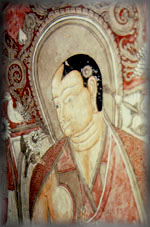 Now Samye lies in ruins, a victim to the madness of the Cultural Revolution.
The grey, white and yellow stripes that adorn most gompas and chortens of
the region are a Samye heritage.
Now Samye lies in ruins, a victim to the madness of the Cultural Revolution.
The grey, white and yellow stripes that adorn most gompas and chortens of
the region are a Samye heritage.
No one is sure about the age of cave monasteries at Luri and Tashi Gelling
both set in remote eastern valleys. Their superb murals suggest a Kashmiri
hand, indicating that they were of very early construction. And, it is likely
that many cave temples are undiscovered. Who knows what treasures lie inside
the man-made caves which pepper these hillsides?
During this trek we shall visit all these ancient sites. We
shall visit these very special places.
![]()
![]() ntil 1992 less than a dozen foreigners had been to Mustang.
Now, in an effort to protect this culture access is limited, with less than
800 trekkers making the journey each year. The requirement to pay high restricted-area
fees, travel with an organised group and take a Liaison Officer, together
with difficult access continue to make the Kingdom of Lo an uncommon destination.
ntil 1992 less than a dozen foreigners had been to Mustang.
Now, in an effort to protect this culture access is limited, with less than
800 trekkers making the journey each year. The requirement to pay high restricted-area
fees, travel with an organised group and take a Liaison Officer, together
with difficult access continue to make the Kingdom of Lo an uncommon destination.
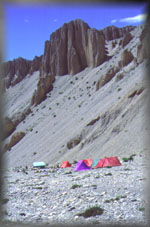
Just as a white summer cloud, in harmony with heaven and earth freely floats in the blue sky from horizon to horizon following the breath of the atmosphere - in the same way the pilgrim abandons himself to the breath of the greater life that...leads him beyond the farthest horizons to an aim which is already present within him, though yet hidden from his sight.
The Way of the White Clouds
Lama Govinda, Hutchinson, 1966

![]()
![]() What’s the general plan?
What’s the general plan?
![]() n the Mustang restricted area we shall trek north through the
infrequently visited eastern districts; then visit Manthang before returning
south along trails in upper valleys that are also less commonly visited by
foreigners. By taking extra time and travelling via the eastern trails we
shall be rewarded in many ways.
n the Mustang restricted area we shall trek north through the
infrequently visited eastern districts; then visit Manthang before returning
south along trails in upper valleys that are also less commonly visited by
foreigners. By taking extra time and travelling via the eastern trails we
shall be rewarded in many ways.
 In 1998 when traversing this route we met one other group on the trail; we
saw the remarkable cave-temple of Luri with its stunning free-drawn images
from 600 years ago; we trekked beneath 'organ-pipes' of wind-carved cliffs
that stand like rows of champagne flutes; crossed a stream which gives birth
to shaligram fossils so prized in the lower valley; and visited un-frequented
villages, Garphu and Nyiphu. These are all features of taking the eastern
trail and having extra days to travel north of Lo.
In 1998 when traversing this route we met one other group on the trail; we
saw the remarkable cave-temple of Luri with its stunning free-drawn images
from 600 years ago; we trekked beneath 'organ-pipes' of wind-carved cliffs
that stand like rows of champagne flutes; crossed a stream which gives birth
to shaligram fossils so prized in the lower valley; and visited un-frequented
villages, Garphu and Nyiphu. These are all features of taking the eastern
trail and having extra days to travel north of Lo.
If you open your eyes, travel in Mustang is to travel through time. A journey
that resonates with childhood dreams of those recent cave-dwelling ancestors
and more distant memories of time before man when the high Himalaya was beneath
a mighty sea. Extraordinary!
 This revised itinerary builds on our experience of Mustang over more than
twelve years. It allots fifteen days to the restricted zone compared to the
ten days offered by most companies. Because of it's length, extended passage
through a restricted area, costs of a liaison officer and internal flights
it may seem expensive but, as always, I suggest you look at what is being
offered and compare with what is available elsewhere. I can guarantee that
it will be a quality experience. There has been interest already expressed
in this trip. Numbers are limited to a total of 12 and bookings will be made
on a first-come basis.
This revised itinerary builds on our experience of Mustang over more than
twelve years. It allots fifteen days to the restricted zone compared to the
ten days offered by most companies. Because of it's length, extended passage
through a restricted area, costs of a liaison officer and internal flights
it may seem expensive but, as always, I suggest you look at what is being
offered and compare with what is available elsewhere. I can guarantee that
it will be a quality experience. There has been interest already expressed
in this trip. Numbers are limited to a total of 12 and bookings will be made
on a first-come basis.

![]()
![]() The trek
The trek
![]() he trek to Mustang is entirely Trans-Himalayan, north
of the main mountain chain. However, there is always plenty of agricultural
activity and village life largely untouched by tourism. The remote and medieval
are right there.
he trek to Mustang is entirely Trans-Himalayan, north
of the main mountain chain. However, there is always plenty of agricultural
activity and village life largely untouched by tourism. The remote and medieval
are right there.
 I design the trek to avoid the crowds and, for those who wish, to discuss
the issues.Our approach march from Jomsom gives some time for your body to
adapt to height and means you are more fit to enjoy time at high altitude.
It creates an air of anticipation which develops the closer one gets to the
restricted zone. I find this more emotionally satisfying.
I design the trek to avoid the crowds and, for those who wish, to discuss
the issues.Our approach march from Jomsom gives some time for your body to
adapt to height and means you are more fit to enjoy time at high altitude.
It creates an air of anticipation which develops the closer one gets to the
restricted zone. I find this more emotionally satisfying.
 The days are not long, usually five to six hours of walking, starting and
finishing early with lots of time for rests and lunch. However, as you walk
up a seemingly endless hill there is opportunity to reflect on Lord Buddha's
first noble truth, that suffering exists! Apart from fitness, the most important
attribute is right attitude. At the start of the trek we visit Muktinath,
famed pilgrimage site for both Hindus and Buddhists. Here you can see such
miracles as burning water (natural gas) and match your footprint against that
of the illustrious sage Guru Rimpoche (Padmasambhava), revered by all people
of Tibetan stock for bringing Buddhism to Tibet and the Himalaya. Refreshed
and possibly enlightened, we trek from here north to Mustang.
The days are not long, usually five to six hours of walking, starting and
finishing early with lots of time for rests and lunch. However, as you walk
up a seemingly endless hill there is opportunity to reflect on Lord Buddha's
first noble truth, that suffering exists! Apart from fitness, the most important
attribute is right attitude. At the start of the trek we visit Muktinath,
famed pilgrimage site for both Hindus and Buddhists. Here you can see such
miracles as burning water (natural gas) and match your footprint against that
of the illustrious sage Guru Rimpoche (Padmasambhava), revered by all people
of Tibetan stock for bringing Buddhism to Tibet and the Himalaya. Refreshed
and possibly enlightened, we trek from here north to Mustang.
...Then one morning we would find the snow-clouds passed away, and see the great peak of Chumalhari emerging calm, strong, and irresistible from out of the mass of cloud still tossing wildly round its base...
and above it lay the calm blue sky, illimitable in its restfulness and light
- a sky of bright and liquid azure, through which one seemed able to pierce right into heaven itself.
India and Tibet, London 1910
From nearby Jomsom we fly to Pokara and Kathmandu.
Our mountain sojourn is at an end.

![]()
![]() How do we travel in Nepal?
How do we travel in Nepal?
![]() e shall fly from Kathmandu to Pohaka; overnight at the Hotel
Annapurna beside the airstrip; then, weather permitting the next morning take
the short flight through the great gorge of the Kali Gandaki to Jomsom; from
here we trek to Mustang; and return by flying from Jomsom to Pokhara and Kathmandu
in one day.
e shall fly from Kathmandu to Pohaka; overnight at the Hotel
Annapurna beside the airstrip; then, weather permitting the next morning take
the short flight through the great gorge of the Kali Gandaki to Jomsom; from
here we trek to Mustang; and return by flying from Jomsom to Pokhara and Kathmandu
in one day. 
![]()
![]() What about the weather?
What about the weather?
![]() e shall be traveling at the preferred time for the Mustang
region. The monsoon does not penetrate significantly beyond the mountains
so at this time the Trans-Himalaya is usually a region of intense blue skys,
hot sunny days and cold nights.
e shall be traveling at the preferred time for the Mustang
region. The monsoon does not penetrate significantly beyond the mountains
so at this time the Trans-Himalaya is usually a region of intense blue skys,
hot sunny days and cold nights.  As
in any mountain region, rain and snow showers can occur at any season. In
1996, '98 and 2001 we had a few days of partially overcast conditions but
no rain, and this pattern is quite standard. In 2005 however we had three
days when it did rain briefly and a couple of nights of quite heavy rain.
Whether this indicates a changing climate or simply seasonal variation is
anyone's guess. To possibly get better weather in 2007 I have scheduled the
trek slightly earlier. You should realize however that this is a guess and
not particularly rational. We live in hope!
As
in any mountain region, rain and snow showers can occur at any season. In
1996, '98 and 2001 we had a few days of partially overcast conditions but
no rain, and this pattern is quite standard. In 2005 however we had three
days when it did rain briefly and a couple of nights of quite heavy rain.
Whether this indicates a changing climate or simply seasonal variation is
anyone's guess. To possibly get better weather in 2007 I have scheduled the
trek slightly earlier. You should realize however that this is a guess and
not particularly rational. We live in hope!
In contrast to the Mustang area, the lower regions of Nepal will be hot and
humid with daily rain showers interspersed with brilliant sunshine.
Holy ones, in Nepal the ground is nothing but rocks,
and it is as humpy as the back of a camel.
Surely you are not going to enjoy your journey?
Comment to early Buddhist
monks
setting out from India ca 430BC
 LAND
ONLY group [join and leave in Kathmandu]
LAND
ONLY group [join and leave in Kathmandu]
![]() hose
who wish to travel elsewhere in Asia or travel on to Europe may prefer this
option. It includes all accommodation in Kathmandu with breakfast; Kathmandu
tours and other activities as for the main group; as well as the trek costs,
park and trek fees and local flights.
hose
who wish to travel elsewhere in Asia or travel on to Europe may prefer this
option. It includes all accommodation in Kathmandu with breakfast; Kathmandu
tours and other activities as for the main group; as well as the trek costs,
park and trek fees and local flights.
N.B. If you choose the land-only option please organise your air travel early.
Flights to and from Asia are very heavily booked. I am happy to help with
suggestions and flight bookings if you wish.
